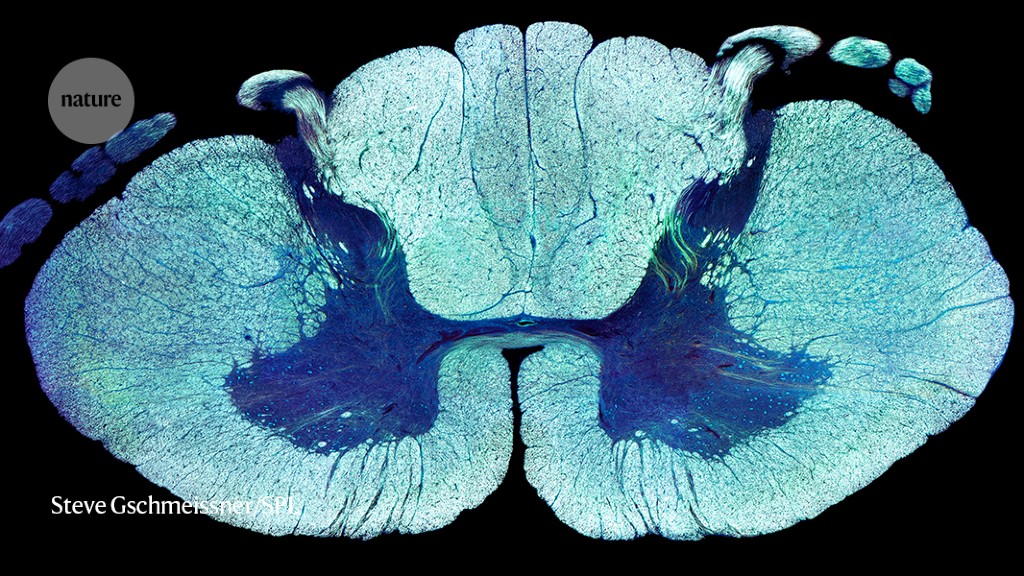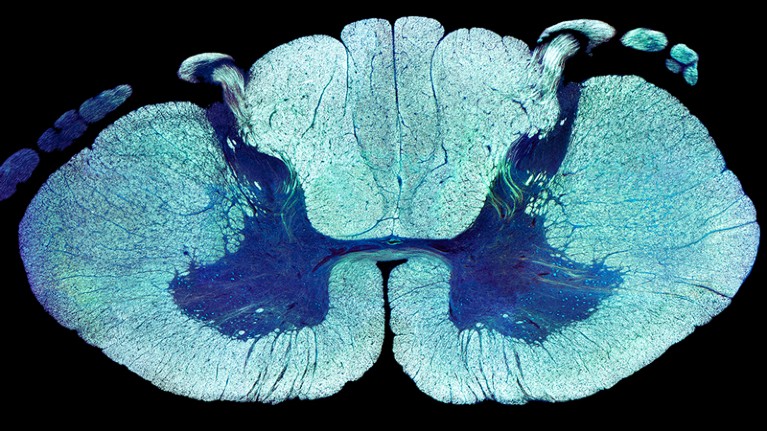Spinal-cord injuries can be partially healed by remodelling of certain neurons.Credit: Steve Gschmeissner/SPL
Neuroscientists have identified the nerve cells responsible for helping paralysed people to walk again, opening up the possibility of targeted therapies that could benefit a wider range of people with spinal-cord injuries1.
Severe spinal-cord injuries can disrupt the connection between the brain and the networks of nerve cells in the lower spine that control walking. In 2018, neuroscientist Grégoire Courtine at the Swiss Federal Institute of Technology in Lausanne and his colleagues showed that delivering electrical pulses to those lower-spine nerves — a technique known as epidural electrical stimulation (EES) — could, when combined with intensive training, get people with this kind of spinal-cord injury walking again2. All three participants in a trial went from having severe or complete motor paralysis and minimal sensation in their legs to being able to take steps on their own, or with a walker or crutches. Two other teams showed similar results that year3,4.
Courtine’s team has now extended the work, showing that the system works in people who have lost all sensation in their legs. The group reports in Nature today that nine participants in the same trial — three of whom had complete paralysis and no sensation in their legs — regained the ability to walk after training paired with EES delivered by devices implanted in their spines. Five months into the trial, all participants could bear their own weight and take steps, using a walker for stability.
Four no longer need the EES to be switched on to walk. This sustained recovery suggests that the stimulation triggers remodelling of the spinal neurons to bring the locomotion network back on line.
“The amount of hope that it gives to people with spinal-cord injury is incredible,” says Marc Ruitenberg, a neurologist at the University of Queensland in Brisbane, Australia, who studies spinal-cord injury.
Dampened activity
Courtine’s team also discovered the neurons responsible for the rehabilitation enhancement. Counter-intuitively, when EES was switched on in people, nerve-cell activity at the site of stimulation decreased. The team used this clue to investigate the process more thoroughly. First, the researchers emulated each aspect of the treatment in mice — from injury and electrical stimulation to training with a purpose-built robotic support for stability. The results mimicked those in people.
Next, the researchers measured gene activity in thousands of individual neurons in samples of mouse spinal tissue. This produced an exquisitely detailed map of nerve cell types in the lower spinal cord. They then used a machine-learning algorithm to search for mouse neurons that showed changes in gene activity at set stages of EES-assisted rehabilitation that paralleled the changes observed in the human participants’ walking ability.
The algorithm identified a subpopulation of excitatory interneurons — nerve cells that connect motor and sensory neurons — that seemed to fit. When Courtine‘s team silenced those cells in injured mice, they found that EES no longer enabled the injured animals to walk.
The overall decrease in neural activity at the site during rehabilitation reflects a learning process, says Courtine. “When you think about it, it should not be a surprise,” he says, “because in the brain, when you learn a task, that’s exactly what you see — there are less and less neurons activated” as you get better at it.
Next steps
Technology doesn‘t exist to gather this kind of direct evidence in people. But Eiman Azim, a neuroscientist at the Salk Institute for Biological Studies in La Jolla, California, says the same neurons are probably responsible for the effect, because spinal architecture is very similar across vertebrates, including humans and mice.
Eventually, says Azim, detailed understanding of the spinal circuitry could allow neuroscientists to manipulate the activity of specific neurons directly with other treatments, such as gene therapy. Stem-cell therapies could one day replace crucial populations of neurons damaged in spinal-cord injuries, says Ruitenberg.
Courtine and his colleagues have also used EES to restore arm movement and hand grip in monkeys5. And a group at the University of Washington in Seattle has done the same for six people with spinal-cord injuries, using non-invasive electrode-bearing skin patches placed on the neck6.
As spectacular as it is to see people with spinal-cord injuries walk again, Ruitenberg says that walking is often not a priority for people. Loss of bladder control, bowel control and sexual function can have a greater impact on quality of life. “It would be really interesting to see whether those sorts of functions also can be improved with this technology,” he says.
Courtine says that identifying the nerves responsible for these functions is on his list of next steps now that he has a detailed molecular map to work with. He has also launched a start-up company — ONWARD, based in the Netherlands — to commercialize the technology. The company will start recruiting 70–80 participants in the United States for a new trial in 2024.






More News
The complete sequence and comparative analysis of ape sex chromosomes – Nature
Advances in highly targeted radiation treatment for cancer have ignited interest in a once obscure field
Reproducible graphene synthesis by oxygen-free chemical vapour deposition – Nature